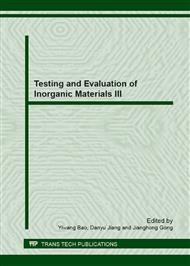p.291
p.295
p.299
p.304
p.310
p.316
p.321
p.326
p.330
Ballistic Performance of TiC-TiB2 Composite Armour under the Impact of Long-Rod Tungsten Alloy Projectiles of 1.4 km · s-1
Abstract:
Based on using combustion synthesis in high-gravity field to prepare the solidified TiC-TiB2 composites, the layered composites of the ceramic to Ti-6Al-4V at graded composition were achieved by fusion joint and atomic inter-diffusion between liquid TiC-TiB2 and Ti-6Al-4V substrate. The mechanical properties showed that the relative density, micro-hardness and fracture toughness of TiC-TiB2 ceramic layer measured 98.5%, 21.5 GPa and 13.5 ± 2.5 MPa • m0.5, respectively, and the shear strength at joint of TiC-TiB2 to Ti-6Al-4V measured 450 ± 25 MPa. By conducting DOP test to evaluate ballistic performance of the ceramic and layered-composite targets against long-rod KE projectiles at impact velocity of 1.4 km • s-1, it was obtained the mass efficiency 3.28 of the solidified TiC-TiB2 was achieved as the impact point of the projectile was nearby the centre of the target, whereas the mass efficiency 3.18 of the layered composite with the solidified ceramic to Ti-6Al-4V was also achieved even if the impact point of the projectile was at the edge of the target. By combining penetration damage of the targets with the dynamic behavior of the ceramic, it was obtained that the layered composite achieved by the joint of the solidified ceramic to Ti-6Al-4V not only improve ballistic performance of the ceramic, but also weaken the sensitivity of the ceramic target against the impact point of KE projectile by tearing the joint of the ceramic with Ti alloy to restrain formation and propagation of conical crack and fracture cone in the ceramic.
Info:
Periodical:
Pages:
310-315
Citation:
Online since:
March 2013
Authors:
Price:
Сopyright:
© 2013 Trans Tech Publications Ltd. All Rights Reserved
Share:
Citation:


